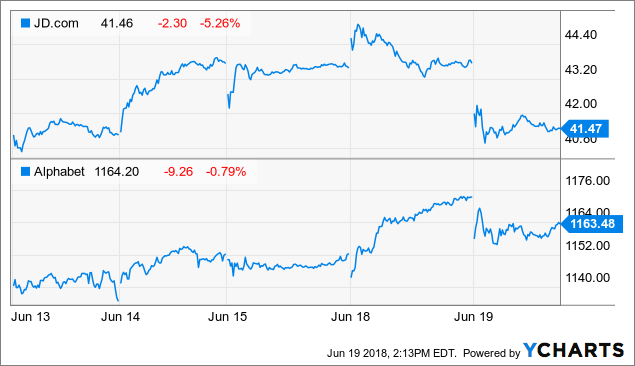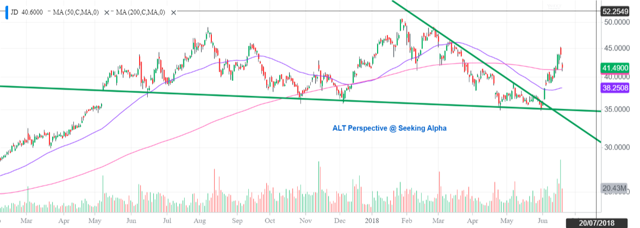JD.com (JD) and Google, the search engine unit of Alphabet (GOOG)(GOOGL) announced a comprehensive partnership following an equity injection exercise with cash from the latter. The news was well received by the market and the share prices of both companies rose on the day of the announcement (June 18).

JD Price data by YCharts
Unfortunately, President Trump reignited the trade kerfuffle with China and the resultant stock market swoon dragged JD down to below its closing price last Friday. That meant the gains from the positive deal with Google had all but disappeared and amazingly it lost even more. President Trump’s warning that a further eye-popping $200 billion worth of imports could be included in the trade war made sentiment worse. Yet, Alphabet managed to stay above the closing price of last Friday.
JD and Google Join Hands
Let’s forget about the share price movement for the time being and look at the implications of the partnership between China’s largest retailer and the highly pervasive internet company with a dominant search engine. First, the deal involves an investment ($550 million) by Google in JD.com. Consequently, this is not a simple collaborative project and Google has a deeper interest to see the partnership bear fruits for long-term benefits.
Interestingly, this appears to tie in well with the Google-Tencent deal which I discussed in a January article to be superbly complementary since Tencent has an equity stake in JD as well (18.1 percent). Given shared interests, I would expect the trio to be working out synergistic initiatives for the benefit of all since the results would be better than if each of the two Chinese players has collaborated in isolation with Google. Citi analyst Alicia Yap suggested that JD could leverage Google’s Shopping Action platform to increase its visibility outside China such as Thailand and Indonesia where JD is currently strengthening its operations in. In the January agreement, Google and Tencent were to collaborate on "future technology developments", a very broad statement.
Secondly, this also meant that JD.com is now owned by two major US corporations - Walmart (WMT) and Alphabet, a strong backing through which JD can leverage on to expand overseas. Walmart came into the picture after JD.com acquired the Chinese online grocery business of Walmart, Yihaodian, in June 2016. In return, Walmart received a 5 percent stake in JD.com. Walmart"s ownership has since doubled to 10.1 percent. Examples of collaboration include a Sam’s Club Flagship Store on JD.com, the Walmart Global Flagship Store on JD Worldwide, and a two-hour delivery service from some Walmart Stores in China through the JD Daojia app.
In this case, again, Walmart has also previously announced a partnership with Google to enter the voice-shopping market as they team up to fight Amazon (AMZN) in its turf. As such, Google has demonstrated its intention to establish broader alliances to achieve greater impact and better synergies.
JD Delivers On 618 Shopping Festival
In my article last month on JD and Alibaba (BABA), I mentioned that the share prices of the two e-commerce giants could benefit from the positive media coverage regarding the sales momentum during the “618” shopping festival. In the 18-day long mid-year shopping extravaganza that concluded on June 18, JD.com did not disappoint. It managed to achieve a 37 percent increase in sales over the prior year’s event. Total sales amounted to RMB 159.2 billion (US$24.6 billion). In contrast, JD made RMB 362.3 billion in revenue in the whole of 2017 and just RMB 100.1 billion in Q1 2018.
Nevertheless, while the share prices of both Alibaba and JD indeed rose in the past weeks, it is practically impossible to quantify how much of the gain was attributable to the hype surrounding the shopping festival, not that the distinction matters for the shareholders though. Periodic affirmation of the duo’s ability to grow sales helps to reassure investors that their stellar growth momentum remains on track and keep short-sellers at bay.
Investor Takeaway
Despite the strong endorsement from Google in the tangible form of an equity injection, the share price of JD only managed to eke out a small gain. Even that little appreciation quickly dissipated after President Trump reignited the trade kerfuffle with China. In fact, JD is now trading below the price before the announcement of the Google deal.
For those concerned on Chinese name over possible accounting shenanigans, you would be pleased to know that JD has recently appointed a respected figure in accounting, Dingbo Xu, to its board. Professor Xu is currently Essilor Chair Professor in Accounting and an associate dean at China Europe International Business School ("CEIBS") in Shanghai and has served on several large public companies" boards, including People"s Insurance of China Limited and China Cinda Asset Management. Professor Xu received his Ph.D. in accounting from the University of Minnesota.
Based on the price chart, JD has broken out of a multi-month descending triangle formation in early June. It has also clearly bounced off the two-year support line which has been well-tested in four prior occasions.
For those waiting to get vested in this top retailer in China or add to an existing position, the sell-down today on the fuzzy impact of a trade war on JD has certainly opened up an opportunity. It is a better time to do so now than last week, with the gains following the complementary tie-up with Google returned to the market. On Monday, JD’s share price hiked more than 10 percent in the pre-opening session. Many investors waiting on the sidelines were likely to have the feeling that the train had left the station. The JD train has returned to the station merely a day later. Would you be on board this time?
What"s your take? Do you think the sell-down is justified? Please freely share your thoughts, let me know if you found this article useful or provide your feedback in the comments section.
Author"s Note: Thank you for reading. If you would like a refreshing take on stocks that you own or are interested in, try looking here. Besides US companies, I cover a number of Asian stocks as well. If you wish to be informed of my new ideas on Seeking Alpha via email so that you have time to read them before the articles get locked behind a paywall 10 days from publication, please select "Receive email alerts" when accessing on a desktop computer.
Disclosure: I am/we are long BABA, JD, TCEHY.
I wrote this article myself, and it expresses my own opinions. I am not receiving compensation for it (other than from Seeking Alpha). I have no business relationship with any company whose stock is mentioned in this article.



